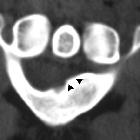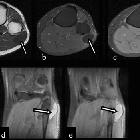Nervenkompressionssyndrom

Recurrent
burner syndrome due to presumed cervical spine osteoblastoma in a collision sport athlete – a case report. Fig 1 Axial (arrowheads) and Fig 2 sagittal CT demonstrate an expansile lesion (arrow) of the posterior arch of C1. It is contained within the cortex with no soft tissue extension. The bony margins appear smooth, homogeneous and sclerotic.

Recurrent
burner syndrome due to presumed cervical spine osteoblastoma in a collision sport athlete – a case report. Sagittal T2 weighted MRI demonstrates an expansile lesion (arrows) of the posterior arch of C1 resulting in significant compression on the posterior thecal sac and spinal cord.
Nervenkompressionssyndrom
Siehe auch:
- Processus supracondylaris
- Kompressionssyndrom des Nervus medianus
- Tarsaltunnelsyndrom
- Kompressionssyndrom Nervus ulnaris
- Kompressionssyndrom Nervus interosseus dorsalis
- Meralgia paraesthetica
- Ulnariskompressionssyndrom durch schnappenden Musculus triceps
- Verletzungen des Plexus brachialis
- neurovaskuläre Kompressionssyndrome
- Nervenkompressionssyndrome der oberen Extremität
- Nervus-suprascapularis-Kompressionssyndrom
- Double-Crush-Syndrom
- peripherer Nervenschaden durch Ganglion
und weiter:

 Assoziationen und Differentialdiagnosen zu Nervenkompressionssyndrom:
Assoziationen und Differentialdiagnosen zu Nervenkompressionssyndrom:Ulnariskompressionssyndrom
durch schnappenden Musculus triceps










